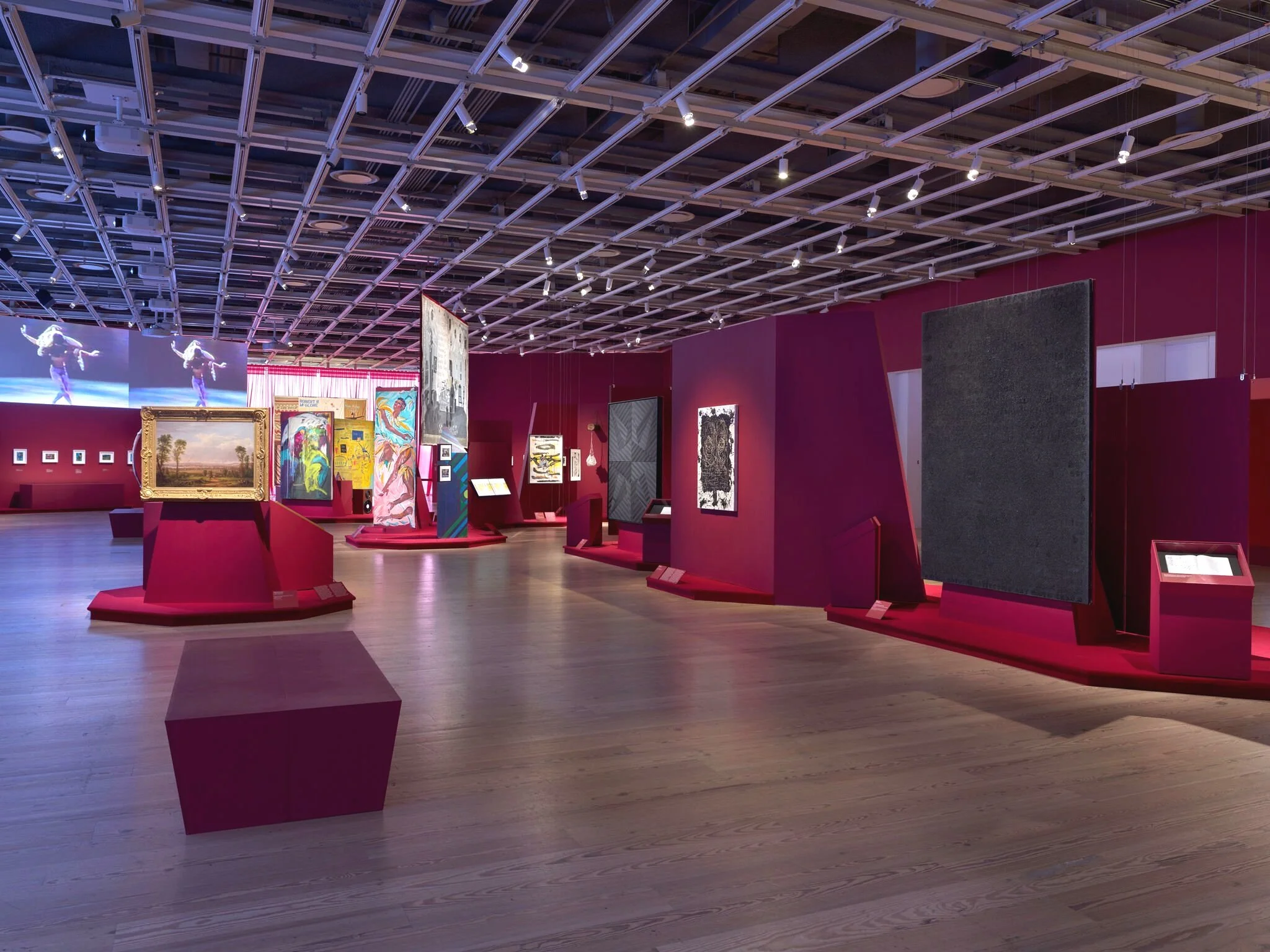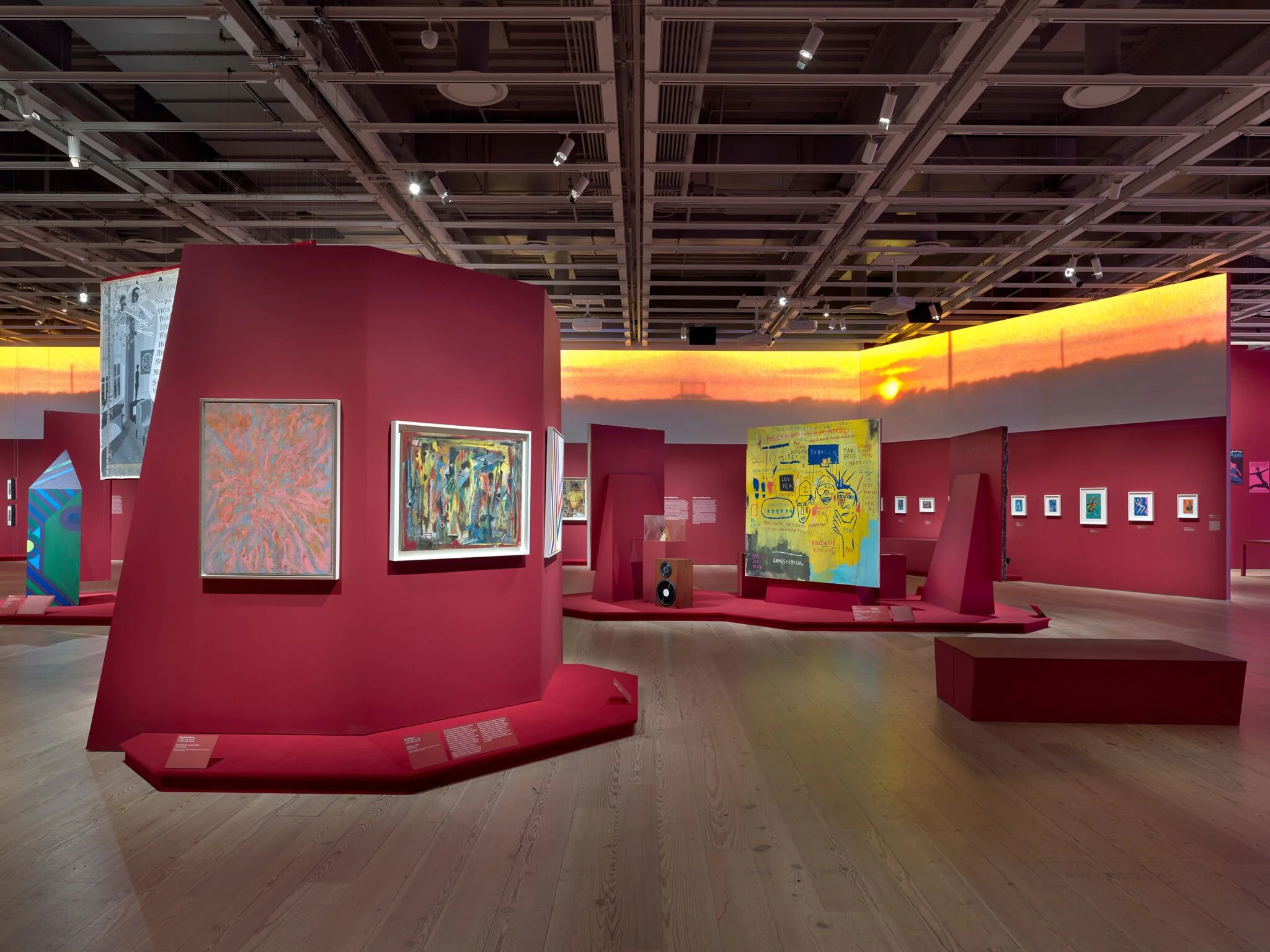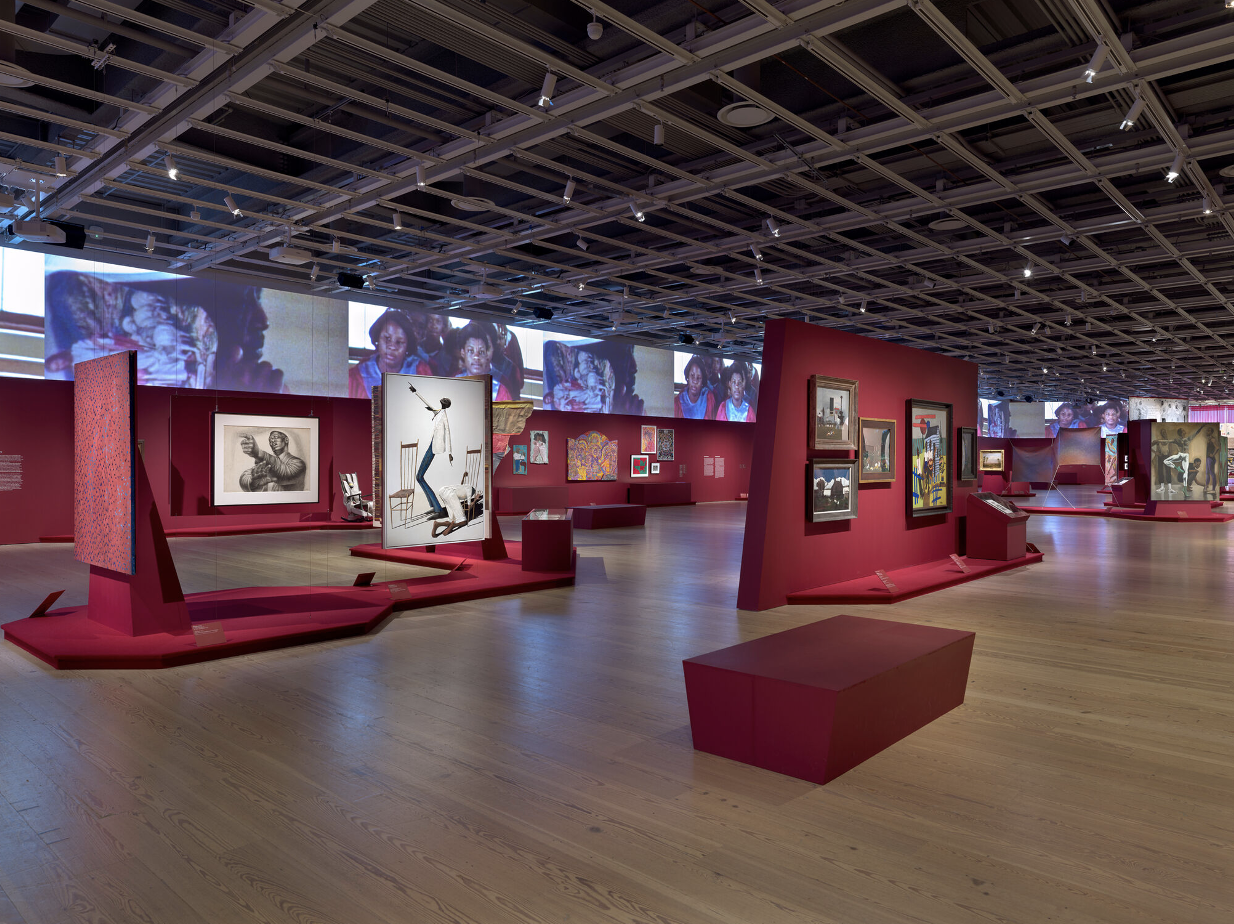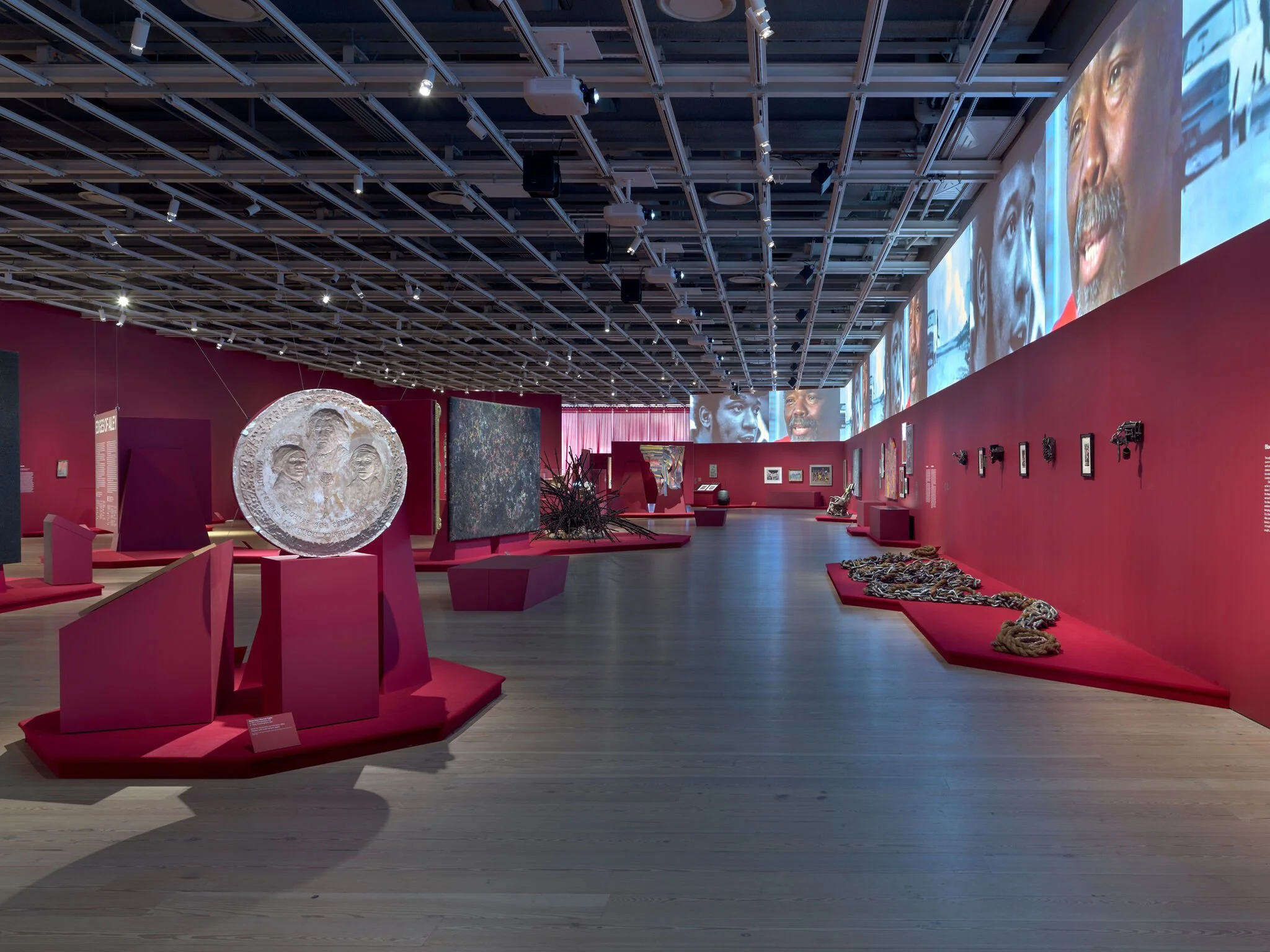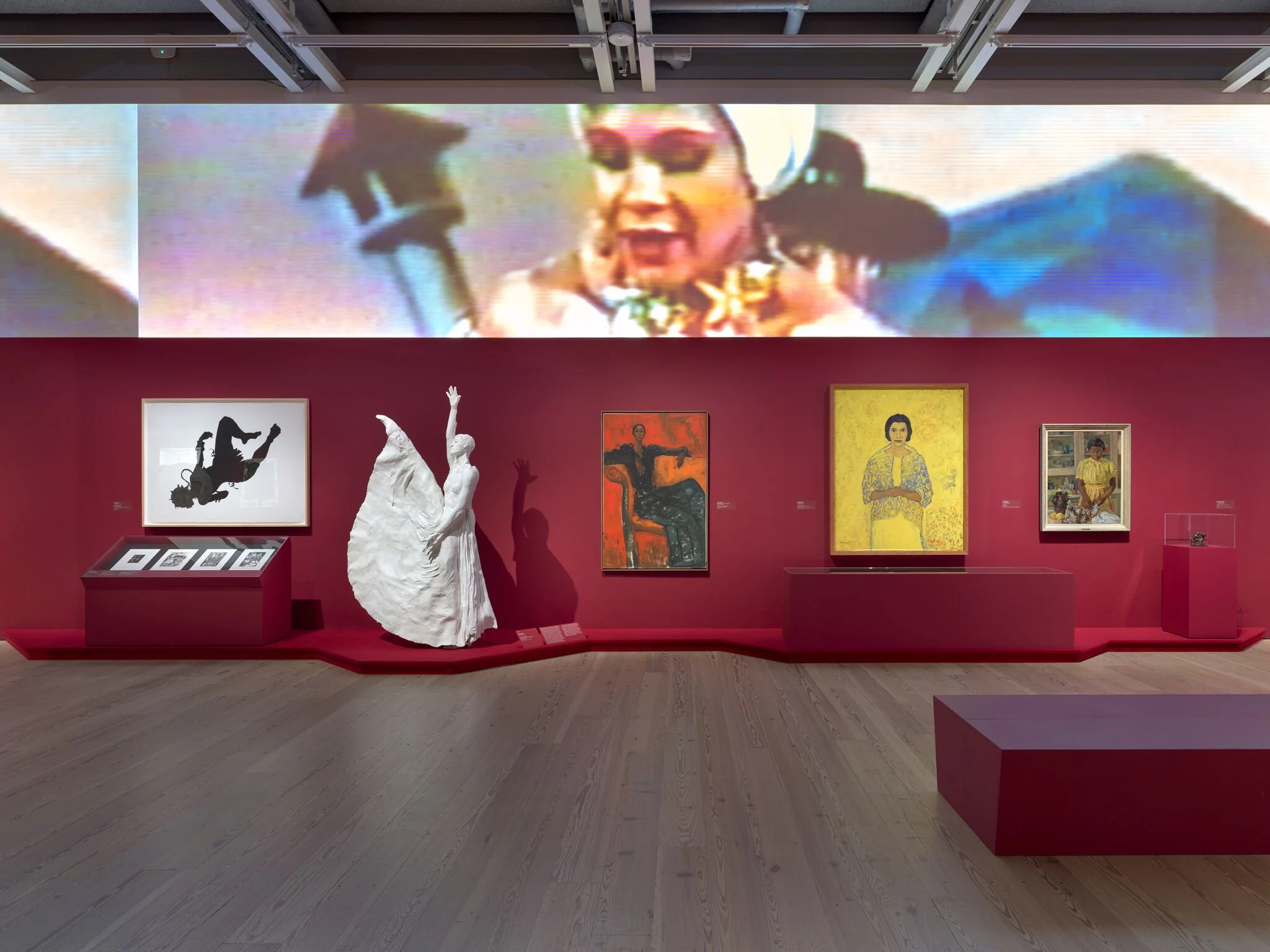At the Edge of Ailey
Tom Koren • 2/1/25
Edges of Ailey, Whitney Museum of American Art, New York
-
On Site is The Curatorial’s section in which writers review exhibitions from a curatorial perspective—not an art review, a curatorial review. This is also a showcase for master’s degree students in the MA Curatorial Practice program at the School of Visual Arts (the home of the journal) to publish as part of the program—though others are welcome to write for On Site as well.
In this review, Adrienne Edwards’s groundbreaking exhibition, concerned with the choreographer Alvin Ailey, is critiqued. The exhibition offers a variety of approaches to delve into Ailey’s work and cultural context. It is spectacular and challenging in ways that are both informative and problematic for our reviewer.
As the Whitney Museum elevator doors open onto the fifth-floor galleries, the Edges of Ailey audience is met with a dizzying spectacle. The vastness of the open space, the dramatically dimmed spotlights, the luscious burgundy walls, the abundance of artworks, and the multi-channel video panorama that envelops the gallery—its soulful and propulsive soundtrack reverberating throughout—combine into a glamorous theatricality, making it feel as though one has emerged directly onto an active stage.
Installation view of Edges of Ailey (Whitney Museum of American Art, New York, September 25, 2024-February 9, 2025). From left to right: Romare Bearden, “The Father Comes Home” from the Bayou Fever series, 1979; Romare Bearden, “Wife and Child in Cabin” from the Bayou Fever series, 1979; Romare Bearden, “The Herb Woman” from the Bayou Fever series, 1979; Romare Bearden, “The Mother Hears the Train” from the Bayou Fever series, 1979; Robert Duncanson, View of Cincinnati, Ohio from Covington, Kentucky, c. 1851; Mary Lovelace O’Neal, Race Woman Series #7, c. 1990s; Jean-Michel Basquiat, Hollywood Africans, 1983; Emma Amos, Judith Jamison as Josephine Baker, 1985; Kerry James Marshall, Souvenir IV, 1998; Ellsworth Ausby, Untitled, 1970; Lorna Simpson, Momentum, 2011; Kandis Williams, Black Box, 4 points: Horton, Ailey, McKayle contractions and expansions of drama from vernacular –– arms outstretched and entangle, 2021; Jacob Lawrence, Figure Study, c. 1970; Terry Adkins, Other Bloods (from The Principalities), 2012; James Little, Stars and Stripes, 2021; Rashid Johnson, Untitled Anxious Men, 2016; Glenn Ligon, Stranger in the Village #12, 1998. Photograph by Ron Amstutz. All images courtesy the Whitney Museum of American Art.
Edges of Ailey, curated by Adrienne Edwards, the Engell Speyer Family Curator and Curator of Performance at the Whitney, honors the trailblazing choreographer Alvin Ailey (1931–1989) and the legacy of his eponymous dance company, founded in 1958 and active to this day. Drawing on Ailey’s innovative, cross-disciplinary, and tentacular approach to modern dance—with inspirations ranging from literature and poetry, music and art, theater and cinema, to history, politics, community, and spirituality—the exhibition seeks to explore and pay homage to the roots and impact of his practice through a unique presentation of visual art complemented by a live dance program in the museum’s theater.
From left to right: Ellsworth Ausby, Untitled, 1970; Kerry James Marshall, Souvenir IV, 1998; Beauford Delaney, Charlie Parker Yardbird, 1958; Norman Lewis, Phantasy II, 1946; Sam Gilliam, Swing 64, 1964; Loïs Mailou Jones, Jennie, 1943; Betye Saar, I’ve Got Rhythm, 1972; Charles Gaines, Sound Box: Nina Simone and Billie Holiday, 2021; Jean-Michel Basquiat, Hollywood Africans, 1983; Romare Bearden, “The Father Comes Home” from the Bayou Fever series, 1979; Romare Bearden, “Wife and Child in Cabin” from the Bayou Fever series, 1979; Romare Bearden, ”The Swamp Witch” from the Bayou Fever series, 1979; Romare Bearden, “The Blue Demons” from the Bayou Fever series, 1979; Romare Bearden, “The Wart Hog” from the Bayou Fever series, 1979; Romare Bearden, “The Lizard” from the Bayou Fever series, 1979; Romare Bearden, “The Hatchet Man” from the Bayou Fever series, 1979. Photograph by Ron Amstutz.
Ailey’s visionary spirit is reflected mainly in the exhibition design. The decision to open up the entire gallery space is daring; there are hardly any separations, and the entirety of the show becomes visible at a glance. Paintings and sculptures are grouped in archipelagos in the center of the space, propped against dark red backings or suspended from the ceiling in a free-standing, Lina Bo Bardi fashion, while other sections of artworks hang on the surrounding walls beneath the video installation. The exhibition includes works from the Whitney’s collection alongside some loans and commissions, all intended to represent or respond to the elements that made up Ailey’s life and artistic persona, together forming one multilayered portrait of the choreographer and an encompassing visualization of Black dance. Interwoven throughout the artworks are personal notebooks, postcards, books, photographs, posters, and other Alvin Ailey American Dance Theater (AAADT) ephemera, densely aggregated inside vitrines. The curatorial strategy aims to form “constellations” that resist a linear or hierarchical narrative, blurring the boundaries between the disciplines and themes that shaped Ailey’s choreography. While this curatorial approach works well conceptually—successfully restaging the multidimensionality, richness, and breadth of Ailey’s influences and accurately capturing the spirit of the time inherent to his practice—there is a sense that the concept comes at the expense of the artworks. The floating islands and dense hanging of works create a slightly disorienting dramaturgy for the audience, resulting in a sight that is as aesthetically dazzling as it is overwhelming, leading to a somewhat superficial encounter with the art on display.
From left to right: Romare Bearden, “Star (Star from the Heavens)” from the Bayou Fever series, 1979; Archibald John Motley Jr., Gettin’ Religion, 1948; Roy DeCarava, Coltrane and Elvin, 1960; Roy DeCarava, Elvin Jones, 1961; Lyle Ashton Harris, Billie #21, 2002; Hale Aspacio Woodruff, Blind Musician, 1935/1998; Norman Lewis, Jazz, 1943–44; Gordon Parks, Music–That Lordly Power, 1993; Mary Lovelace O’Neal, Race Woman Series #7, c. 1990s; Terry Adkins, Other Bloods (from The Principalities), 2012; Bill Traylor, Untitled (Man in a Blue House), date unknown; Ralph Lemon, Bongos and Djembe, 1999; Ralph Lemon, Untitled (On Black music), 2001-07; Ralph Lemon, Untitled (Miles Davis), 2006; Mickalene Thomas, Katherine Dunham: Revelation, 2024. Photograph by Ron Amstutz.
The selection of artworks elegantly unpacks the era and situates Ailey’s oeuvre within a larger sociopolitical context, tying an important interdisciplinary link between his many realms of influence and the figures he was in dialogue with. The focus on his upbringing in the American South and the historical emphasis on Black migration and liberation work to elucidate just how groundbreaking and unprecedented his worldwide success was at the time. That being said, the sensory overload resulting from the large amount of works, their clustered, salon-style hanging, and the all-encompassing presence of the video installation limits a deeper engagement with each thematic section and with the individual pieces within it. The thematic groupings often feel loose or associative, with artworks serving as explicit visualizations of broad and abstract topics. For instance, the section dedicated to the influence of Black women on Ailey’s life includes paintings of Black women or mothers, while his struggle with mental health is illustrated by Rashid Johnson’s Untitled Anxious Men (2016), which depicts an abstracted and distraught figure, its features frenetically etched into thick black wax. While the porousness of the different sections is intended as part of the constellational curatorial vision, they are at times confusing to navigate through. This isn’t always made easier by the didactics, which are often too small or placed in strange, inconvenient locations such as the floor or in the middle of a section, surfacing only after you’ve spent a moment wondering what you are looking at and how it ties into the exhibition. To a viewer who isn’t well versed in Ailey’s world, this makes it difficult to distinguish which of the artworks have a direct connection to his life or practice, and which are included to illustrate abstract elements of his biography. The juxtapositions of the works rarely form illuminating conceptual connections that enhance their individual presence or enrich the internal logic of each section, resulting in a whole that may be greater than the sum of its parts, yet, on balance, offers a spectacle that is somewhat flattening.
From left to right: Sam Doyle, Frank Capers, 2023; Sam Doyle, LeBe, 1970s; Wadsworth Jarrell, Together We Will Win, 1973; Faith Ringgold, United States of Attica, 1971; Wadsworth Jarrell, Revolutionary (Angela Davis), 1972; James Van Der Zee, Marcus Garvey Rally, 1924; Jeff Donaldson, Soweto/So We Too, 1979. Photograph by Ron Amstutz.
To the left of the exhibition space is a section of archival ephemera, dominated by a double-sided row of old TV monitors that plays black-and-white videos. The source materials are dedicated to Ailey’s influences and collaborators, ranging from specific choreographers, artists, and musicians to broader themes like Hollywood or Broadway. These are also inadequately contextualized in the didactics. Their connection to his practice is often too unclear or too loose, and the lack of seating doesn’t aid viewers in the extended type of engagement that can illuminate the works or inspire the audience. In the absence of time-based media that actually depicts Ailey’s practice itself, the amount of videos dedicated to his influences is disproportionate, lacking anything substantial for viewers to tie it back to. This also applies to the archival documents presented in vitrines throughout the space, where Ailey’s personal notebooks and correspondences mainly function as material relics since they are usually too illegible to consume as content.
From left to right: Alma Thomas, Mars Dust, 1972; Charles White, Preacher, 1952; Lonnie Holley, Sharing the Struggle, 2018; Benny Andrews, The Way to the Promised Land, 1994; Sam Doyle, Frank Capers, 2023; Sam Doyle, LeBe, 1970s; Wadsworth Jarrell, Together We Will Win, 1973; Faith Ringgold, United States of Attica, 1971; Wadsworth Jarrell, Revolutionary (Angela Davis), 1972; James Van Der Zee, Marcus Garvey Rally, 1924; Jeff Donaldson, Soweto/So We Too, 1979; Horace Pippin, School Studies, 1944; Horace Pippin, Cabin in the Cotton, c. 1931–37; Horace Pippin, Knowledge of God, 1944; William H. Johnson, At Home in the Evening, c. 1940; John Biggers, Sharecropper, 1945; Robert Duncanson, View of Cincinnati, Ohio from Covington, Kentucky, c. 1851; Joe Overstreet, Purple Flight, 1971; Emma Amos, Judith Jamison as Josephine Baker, 1985; Kerry James Marshall, Souvenir IV, 1998; Lynette Yiadom-Boakye, A Knave Made Manifest, 2024; Lynette Yiadom-Boakye, Fly Trap, 2024; Missa Marmalstein and other makers unknown, Block 1871 of the AIDS Memorial Quilt, 1987. Photograph by Ron Amstutz.
It is important to note that the decision to represent dance through various mediums—showcasing not only Ailey's choreography but also his concerns, the art that interested him, and the art that bounds the experience of Blackness—is, of course, an important endeavor—and one that continues the correction of the historical imbalance of the representation of Black artists in American institutions, both in collections and exhibitions. But are paintings and objects really the best way to convey the history and legacy of dance? One thing that starkly stands out about the exhibition is that, despite its insertion of dance into the museum, Edges of Ailey upholds the traditional division of visual art and live performance. While the exhibition design and content do transcend disciplinary borders in various ways, the show is largely made up of conventional, two-dimensional, static visual art forms. Described as a “dynamic showcase” by the Whitney website, the exhibition is surprisingly dominated by a stillness of objects, despite the presence of scattered videos, as well as the video frieze atop one long wall of the space. The artworks remain divided from live performance, which is relegated to a separate black-box theater’s ticketed performances in allocated time slots. Considering that the show was initiated by a renowned curator of performance art, it would have been interesting to include a durational, unpredictable, or experimental live element within the gallery space.
From left to right: Maren Hassinger, River, 1972/2012; Melvin Edwards, Utonga (Lynch Fragment), 1988; Aaron Douglas, Bravado, 1926; Melvin Edwards, Chitungwiza from the Lynch Fragment series, 1989; Aaron Douglas, Flight, 1926; Melvin Edwards, Katura from the Lynch Fragment series, 1986; Aaron Douglas, Surrender, 1970; Melvin Edwards, Cup of? From the Lynch Fragment series, 1988. Photograph by Ron Amstutz
Even the musical aspects of Ailey’s practice are referenced illustratively and two-dimensionally, with paintings of instruments and a Billie Holiday photograph standing in for more creative auditory forms. The only music that is vibrantly present comes from that sprawling 18-channel video frieze, which is the one truly dynamic and innovative element in the show. The hour-long, looping montage features footage from the AAADT archive paired with a soundtrack of both timeless and contemporary music—ranging from Pharoah Sanders to Donny Hathaway to House music cuts—that is overlaid with interview clips. However, the video’s elevated placement causes it to function more decoratively as a backdrop to the still works, rather than as an artwork in its own right. This feeling is amplified by the fact that the video is uncredited and unexplained within the gallery space, with details about its creators—filmmakers Josh Begley, Kya Lou, and the curator—available only on the website. Were there additional time-based or performative media within the exhibition that referenced Ailey’s practice, this panoramic strip would have sufficed as a curatorial element alone.
From left to right: Purvis Young, Ocean, 1975; Meta Vaux Warrick Fuller, Mold for Crusaders for Freedom, 1962; Sam Gilliam, Untitled (Black), 1978; David Hammons, Untitled, 1992; Al Loving, Untitled, c. 1975; Hale Aspacio Woodruff, By Parties Unknown, 1935, printed 1996; Hale Aspacio Woodruff, Giddap, 1935, printed 1996; Purvis Young, I Love Your America, late 1970s; Martin Puryear, The Rest, 2009-10; Samella Lewis, Migrants, 1968; Purvis Young, Black People Migrating West, late 1970s; William H. Johnson, Moon Over Harlem, 1943-44; Lonnie Holley, Sharing the Struggle, 2018; Theaster Gates, Minority Majority, 2012; Sam Doyle, Frank Capers, 2023; Sam Doyle, LeBe, 1970s; Wadsworth Jarrell, Together We Will Win, 1973; Faith Ringgold, United States of Attica, 1971; Wadsworth Jarrell, Revolutionary (Angela Davis), 1972; James Van Der Zee, Marcus Garvey Rally, 1924; Jeff Donaldson, Soweto/So We Too, 1979; Maren Hassinger, River, 1972/2012; Melvin Edwards, Utonga (Lynch Fragment), 1988; Aaron Douglas, Bravado, 1926; Melvin Edwards, Chitungwiza from the Lynch Fragment series, 1989; Aaron Douglas, Flight, 1926; Melvin Edwards, Katura from the Lynch Fragment series, 1986; Aaron Douglas, Surrender, 1970; Melvin Edwards, Cup of? From the Lynch Fragment series, 1988. Photograph by Ron Amstutz.
While this immersive video installation is mesmerizing and atmospheric, its fast-paced edits offer limited insight into the essence of Ailey’s choreography. Without prior familiarity with his work or access to the museum’s sold-out performances, I left the show without any clear sense of what Ailey’s choreography is actually like. Ultimately, while the exhibition aims to celebrate Ailey’s groundbreaking legacy and cross-disciplinary influence, it fails to foundationally destabilize disciplinary boundaries in practice, or to reimagine new ways of presenting an archive through performance. By relying on representations instead of recreations and pointing at ideas instead of performing them, Edges of Ailey looks backward, surveying the past more than it experiments with possibilities for the future.
In vitrine, from left to right: Elizabeth Catlett, I am the Negro Woman, 1947, printed 1989; Elizabeth Catlett, In Harriet Tubman I helped hundreds to freedom, 1946, printed 1989; Elizabeth Catlett, In Sojourner Truth I fought for the rights of women as well as Negroes, 1947, printed 1989; Elizabeth Catlett, In Phillis Wheatley I proved intellectual equality in the midst of slavery, 1946, printed 1989; From left to right: Kara Walker, African/American, 1998; Karon Davis, Dear Mama, 2024; Geoffrey Holder, Portrait of Carmen de Lavallade, 1976; Beauford Delaney, Marian Anderson, 1965; Loïs Mailou Jones, Jennie, 1943; Meta Vaux Warrick Fuller, Mother and Child (Secret Sorrow), c. 1914. Photograph by Ron Amstutz.
-
Tom Koren is currently a student in the MA Curatorial Practice program at the School of Visual Arts, New York. She received her B.A in Art History and English Literature at the Tel Aviv University. Her professional experience is rooted in the music field, working as a curator, DJ, marketing manager and creative director for leading alternative cultural institutions and events in Tel Aviv. She has recently been awarded a Fulbright fellowship in the Public Humanities program, with which she aims to merge her academic and professional backgrounds by crossing over to the visual art field, experimenting with the curation of interdisciplinary events and further exploring her interest in participatory and live art practices.

